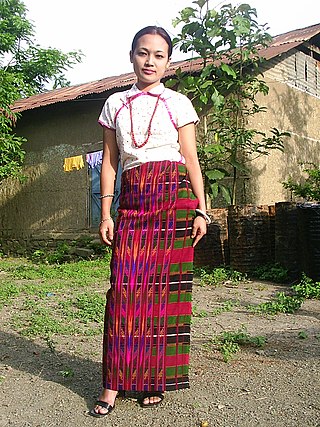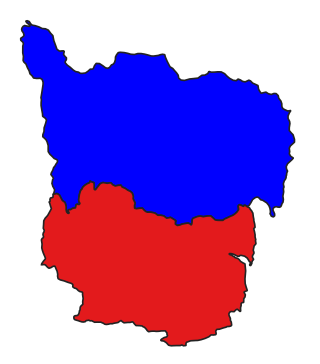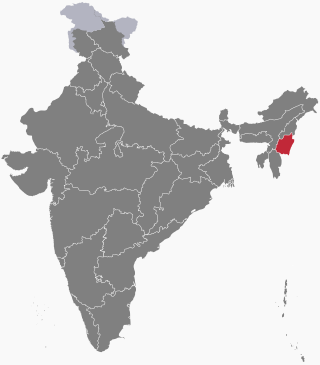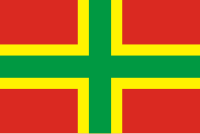
The Chin people are an ethnic group native to the Chin State and Rakhine State of Myanmar. Strictly speaking, the term "Chin" only refers to the 53 sub-tribes of the Chin ethnic group, divided and recognized by the Burmese government. They speak the Kuki-Chin-Mizo languages, which are often mutually unintelligible but are closely related.
The Paite people are an ethnic group in Northeast India, mainly living in Manipur and Mizoram. The Paites are recognized as a scheduled tribe in these two states. They are part of the Kuki-Zo people, but prefer to use the Zomi identity. "Guite" is a major clan of the Paite people.

The Kuki people are an ethnic group in the Northeastern Indian states of Manipur, Nagaland, Assam, Meghalaya, Tripura and Mizoram, as well as the neighbouring countries of Bangladesh and Myanmar. The Kukis form one of the largest hill tribe communities in Northeast India, along with the adjoining regions of Bangladesh and Myanmar. In Northeast India, they are present in all states except Arunachal Pradesh. The Chin people of Myanmar and the Mizo people of Mizoram are kindred tribes of the Kukis. Collectively, they are termed the Zo people.

The Zou people Is are an ethnic group, that is an indigenous community living along the frontier of India and Burma, they are a sub-group of the Kuki people/Zo people. In India, they live with and are similar in language and habits to the Thadou people and Paite and the Simte peoples. In Burma, the Zou are counted among the Chin people. They are a hill people, "Zou" may plainly means "Hills" denoting the Zous are "people of the hills" or "of the hills", and "Zou" has also a different meaning in Zou language that is "complete" or another word for it is "finish". But, the Zou people believed that they incepted the name 'Zou' from their forefather 'Zou' or 'Zo', believed to be the progenitor of the broad Chin-Kuki-Mizo people.
Zo is a Northern Kuki-Chin-Mizo language originating in western Burma and spoken also in Mizoram and Manipur in northeastern India.
Guite is the progenitor clan of Zomi people, also called Chin in Myanmar, Mizo, or Paite, or even Kuki in India. According to Zam, Nigui Guite is the elder brother of the ancestral fathers of the Thadou people, namely Thangpi, Sattawng, and Neirawng. This genealogy was recently inscribed on the tribal memorial stone at Bungmual, Lamka in the presence of each family-head of the three major clans, Doungel, Kipgen, and Haokip, on August 7, 2011. Some historians, like Shakespeare, assumed Lamlei was the Nigui Guite himself but the Guites themselves recounted Tuahciang, the father of Lamlei, as the son of Nigui Guite instead, in their social-religious rites. Regarding Guite as the born son of Songthu and his sister, Nemnep, it was the practice of ancient royalty to issue royal heir and also to keep their bloodline pure instead. Depending on local pronunciation, the clan was also called by different names such as Nguite or Vuite, Gwite, Nwite, Paihte by the Lushei. In accord with the claim of their solar origin, the Guite clan has been called nampi, meaning noble or major or even dominant people, of the region in local dialect in the past.

Tedim Township is in Tedim District, Chin State of Myanmar (Burma). The administrative centre for the township is the town of Tedim. Tedim Township is the most populous township in Chin State, with a population of 87,623.
The Sukte are one of the clans of Tedim Chins that mainly inhabit the Tedim district in Myanmar, with small numbers in India, in Manipur, Meghalaya and Assam states. They are recognized as a Scheduled Tribe in Manipur. From 1995, they have been part of the Zomi Re-unification Organisation in Manipur.
The Tedim people, also called Tedim Chins and Tiddim (Hai-Dim) people, are a Zomi ethinic group, part of the Chin people, primarily inhabiting the Tedim Township in the Chin State of Myanmar. They speak the Tedim language, a northern Kuki-Chin language.
The Kuki-Chin-Mizo languages are a branch of the Sino-Tibetan language family spoken in northeastern India, western Myanmar and southeastern Bangladesh. Most notable Kuki-Chin-speaking ethnic groups are referred to collectively as the Zo people which includes: the Mizo of Mizoram, the Kuki of Manipur, Assam, Nagaland, Tripura and Bangladesh and the Chin of Chin State, Myanmar.
The Kuki–Paite Conflict, also called Kuki–Zomi Conflict, was an ethnic conflict during 1997–1998 between tribal communities in Churachandpur district in Manipur, India. The cause of the conflict may be regarded as the desire for leadership within the tribes, pitting one group that subscribed to the Kuki label against another group that subscribed to the Zomi label, the latter being led by the Paites. The conflict started in June 1997 and lasted for over year, during which 352 people died, thousands of homes were destroyed and over 13,000 people were displaced. The Government of India sent in the Indian Army to attempt to stop the violence, but peace was restored in September–October 1998 only with the initiative of the Church.
The Zo people is a term to denote the ethnolinguistically related speakers of the Kuki-Chin languages who primarily inhabit northeastern India, western Myanmar, and southeastern Bangladesh.
The Zomi people are one of the main groups of the Zo (Kuki-Chin-Mizo) tribes. They live in mostly the India–Myanmar border, as well as in Bangladesh. The Zomi encompasses the various tribes like Paite and Chin, and the Zomi tribe that is called Chin is the Tiddim/Tedim. They call themselves Zomi and they speak their own language. The Zomi language is basically the language of the Tedim/Tiddim and is related to the Paite language.

The Insurgency in Manipur is an ongoing armed conflict between India and a number of separatist rebel groups, taking place in the state of Manipur. The Insurgency in Manipur is part of the wider Insurgency in Northeast India; it displays elements of a national liberation war as well as an ethnic conflict.

The Zomi Congress for Democracy, formerly Zomi National Congress, is a political party in Myanmar. Originally formed in Manipur, India, most of its current support comes from Chin State, where the party was originally headquartered. The party is most popular in the Tonzang, Tedim, and Kalay Townships where their headquarters and strongholds are. The party has 15,000 members in Chin State.

The Kuki National Army (KNA) is a Kuki insurgent group active in Myanmar,but not functioning properly in Northeast India. It is the armed wing of the Kuki National Organisation.
Northern Kuki-Chin is a branch of Kuki-Chin languages. It is called Northeastern Kuki-Chin by Peterson (2017) to distinguish it from the Northwestern Kuki-Chin languages. VanBik (2009:31) also calls the branch Northern Chin or Zo.
The Kuki National Organization (KNO) is a political organization established in 1988, with the aim of representing the interests of the Kuki people in northeast India and northwest Myanmar (Burma). The organization operates alongside its principle armed wing, the Kuki National Army (KNA), and has been active in advocating for the rights and aspirations of the Kuki community.

The Chinland Defense Force is a rebel group in Myanmar. It was formed in response to the 2021 Myanmar coup d'état to protect Chin State from the military junta. The CDF claims that they do not attack the military without cause and that they always issue a warning, such as releasing detainees and refraining from using violence against civilians. If the military does not respond, guerrilla or other action follows. They promise to return their weapons and disband if the revolution is successful. CDFs are members of CJDC. Chinland Joint Defense Committee (CJDC) is formed to serve Chin people's security services and protect an enemy from the illegal Myanmar Army. The total strength of active personnel under the command of CJDC is approximated to be around 15,000. From August to October 2021, it was reported that at least 40 clashes occurred between junta troops and CDF in various townships. CJDC claimed that at least 1,029 Tatmadaw soldiers were killed in the clashes and lost 58 of their own in 2021.
Ukha Loikhai is a village in the Churachandpur district of Manipur, India. It is on the western slopes of the Thangjing Hill and has ongoing claims to the top of the hill itself. In the 2011 census, Ukha Loikhai had a population of 418 people. Ukha was one of the leading villages in the Kuki Rebellion of 1917–1919.








